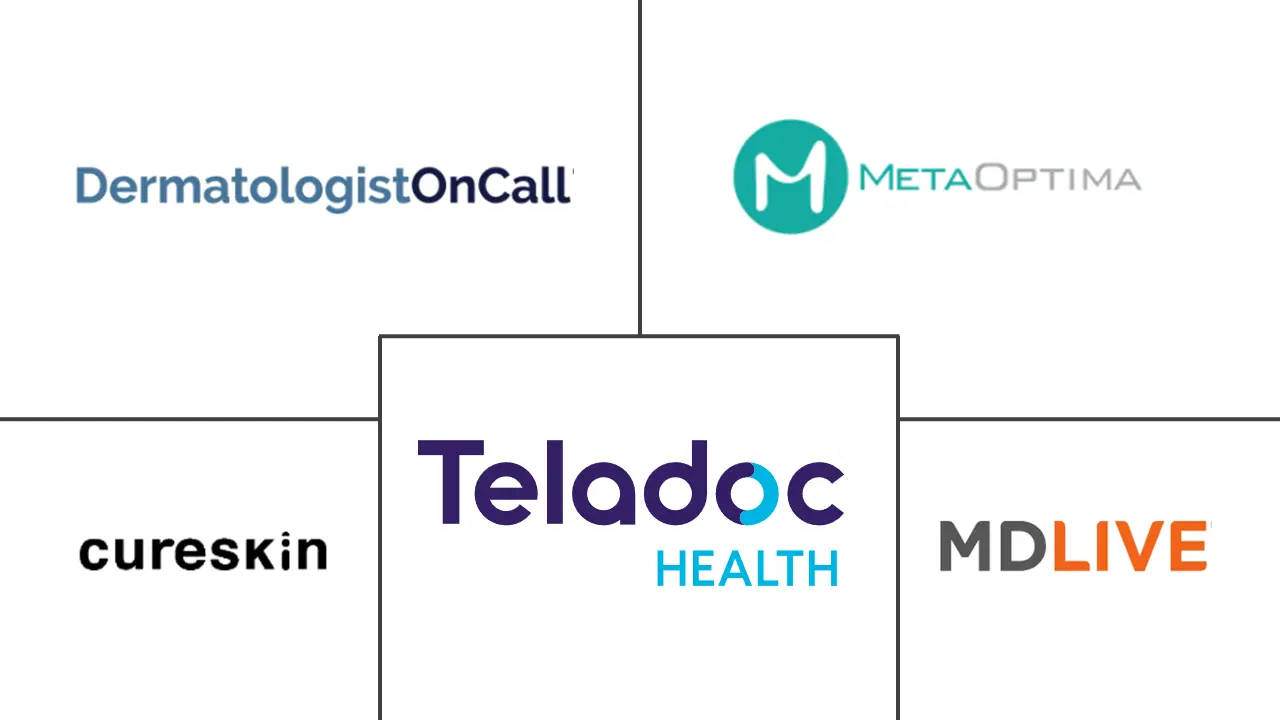Teledermatology Market Size and Share
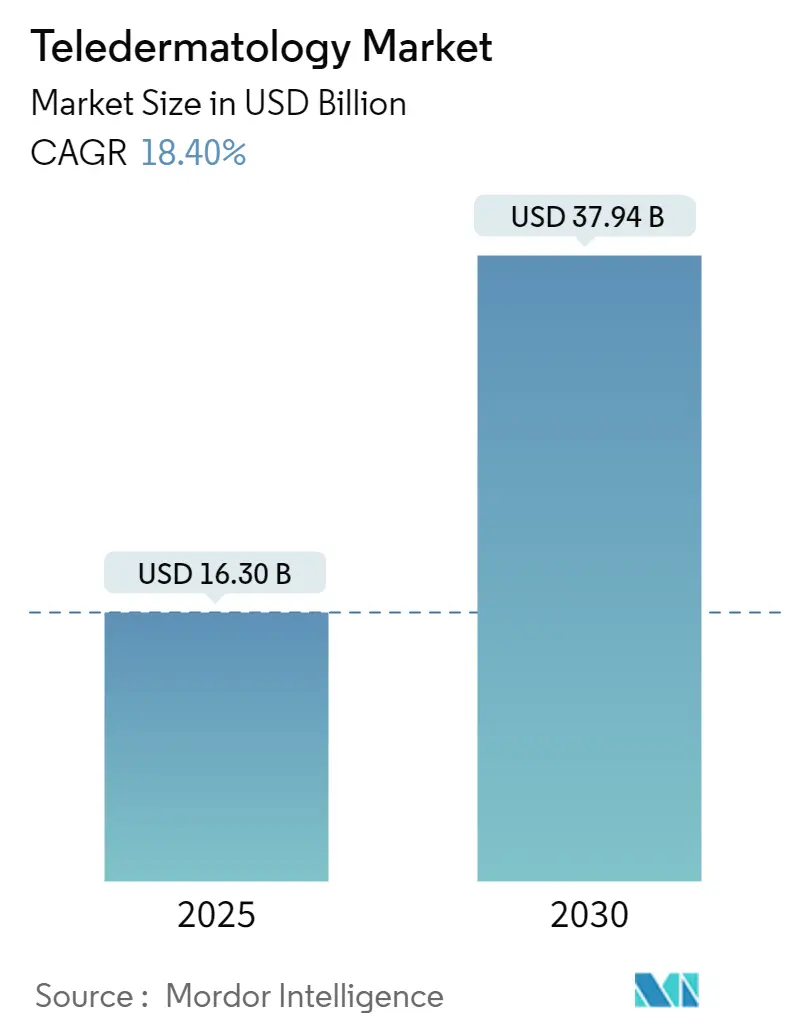
Teledermatology Market Analysis by Mordor Intelligence
The Teledermatology Market size is estimated at USD 16.30 billion in 2025, and is expected to reach USD 37.94 billion by 2030, at a CAGR of 18.4% during the forecast period (2025-2030).
Teledermatology is a subfield of telemedicine that uses telecommunication technology to provide dermatology care remotely. It enables the exchange of images and medical information through secure platforms for evaluation and diagnosis and remotely offers treatment to patients with skin problems. The demand for teledermatology is increasing with the rise of the digital age and improving access to dermatological care, particularly in remote and underserved areas. The lack of dermatologists and the increasing incidence of skin conditions such as psoriasis, eczema, and acne are surging the demand for teledermatology. For instance, according to an article published by the British Skin Foundation in November 2023, currently, there are around 2,000 different dermatological conditions, and teledermatology can address around 90% of them, including skin cancer. Moreover, the convenience, accessibility, and cost-effectiveness of teledermatology offered to patients and healthcare providers are significant factors influencing market growth.
Furthermore, the lack of dermatologists and limited access to dermatology care in low- and middle-income countries due to geographical barriers, long waiting times, and mobility issues are surging the adoption rate of teledermatology, subsequently fueling the market growth. For instance, in a study published by the Indian Journal of Dermatology, Venereology, and Leprology in December 2023, there was less than one dermatologist per million population in sub-Saharan Africa in 2022. In contrast, there were 34 dermatologists per million population in the United States in 2022. Hence, teledermatology is a powerful educational and clinical support tool for diagnosing and managing skin diseases in countries lacking dermatologists. Implementing this technology to improve access to dermatology care will drive market growth over the coming years.
In addition, technological advancements introduced by market players in the teledermatology systems to provide more accurate diagnosis and treatment recommendations, coupled with more advanced imaging and data analysis capabilities, are expected to fuel the market growth. For instance, in September 2022, MCI Onehealth Technologies Inc., a healthcare technology company, and Oro Health, an artificial intelligence solution provider, collaboratively developed and launched the MCI Dermatology Connect platform. The platform provides specific solutions for virtual dermatology care, including secure transfer of high-resolution imaging between patient and specialist. The comfort and benefits that teledermatology offers over long wait times for in-person visits are anticipated to drive the demand for teledermatology between 2024 and 2029.
However, privacy and security concerns, lack of adherence to the regulatory framework, and lack of reimbursement facilities in emerging countries are expected to restrain the market growth from 2024 to 2029.
Global Teledermatology Market Trends and Insights
The Services Segment is Expected to Have Significant Growth in the Market Between 2024 and 2029
Teledermatology offers various services, such as teleconsultation, telemonitoring, and tele-education. It provides numerous benefits such as convenience, access to specialized care, reduced healthcare costs, improved health outcomes, and increased patient engagement. These benefits are surging the adoption of teledermatology services over traditional in-person visits to cater to the increasing demand for dermatology care, which favors segment growth between 2024 and 2029. For instance, according to a report published by News-Medical.Net in October 2023, Consultant Connect’s PhotoSAF technology is one of the United Kingdom’s most widely used teledermatology platforms, covering over half of the NHS across England, Scotland, and Wales. After the launch of the Consultant Connect platform, its usage increased by 2,400% in 2023 compared to the previous four years. Hence, such instances support the idea that teledermatology services enhance patient experience and improve health outcomes, allowing them to drive segmental growth from 2024 to 2029.
Moreover, telemedicine has emerged as an essential tool in cases where diagnoses and treatment are straightforward, such as acne, hair disorders, and dermatitis. For instance, according to a study published by the Telemedicine and e-health Journal in October 2023, the most frequent reason for patients using teledermatology in Germany was high waiting time to avail dermatology care in the outpatient department. Furthermore, as per the same source, 62.0% of the enrolled patients rated the treatment success as good or very good, whereas 86.1% rated the quality of telemedical care as equivalent or better to that of an outpatient visit. Additionally, the study published by the Life Journal in April 2023 stated that the accuracy of atopic dermatitis diagnosis through telemedicine service was 84.4%. Such studies highlighted that as more patients and healthcare providers become familiar with telemedicine, it is likely that teledermatology services will continue to expand in the upcoming years.
Additionally, active investments made by market players to increase awareness about skin diseases and outreach to dermatology care are contributing to segmental growth. For instance, in March 2024, the Health Science Department of Dermatology of George Washington University School of Medicine received a USD 500,000 sponsorship from Johnson & Johnson Innovative Medicine for its free teledermatology program, EACH one TEACH one. The programs aim to enhance access to dermatology care across the country. Such initiatives increase the accessibility and affordability of dermatological care, driving the demand for teledermatology and contributing to segment growth from 2024 to 2029.
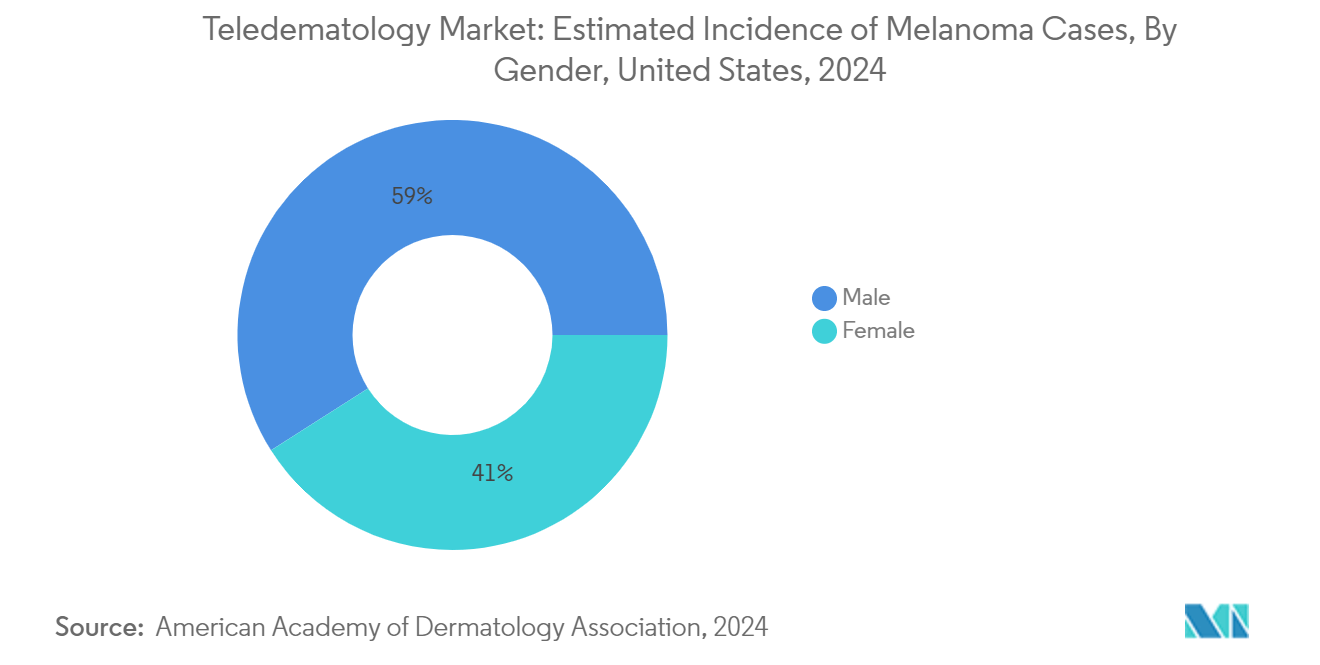
North America is Expected to Hold a Significant Share in the Market Between 2024 and 2029
North America is expected to have a significant share in the market owing to factors such as the increasing burden of skin disease, with rapid acceptance and penetration of telehealth by healthcare facilities contributing to the segment growth over the study period. In addition, a strong presence of established players offering a wide range of solutions and access to developed healthcare infrastructure is anticipated to drive market growth across the region. For instance, according to a study published by JMIR Dermatology in August 2023, teledermatology was widely accepted in North America, followed by Europe, compared to other regions with poor geographical distributions of doctors, which appear to be underrepresented. Several studies reveal high levels of user satisfaction in teledermatology over the last two years across this region.
Furthermore, the market is driven by increased funding from government and non-government organizations to raise awareness and accessibility related to skin diseases. For instance, in December 2023, the Skin Investigation Network of Canada received USD 2 million from the Canadian Institutes of Health Research over five years to tackle the causes, clinical aspects, health systems, and population health questions for a broad range of skin conditions across the country. Hence, these initiatives increase the adoption of teledermatology, thus contributing to market growth.
Additionally, several prominent players in the market are focused on expanding their geographical presence, which in turn is projected to create numerous growth opportunities for the market, thereby influencing market growth in the region. For instance, in April 2023, MedX Health, a key player in teledermatology, agreed with PharmaChoice Canada to launch the MedX teledermatology screening platform across Canada. Such strategic initiatives by key players contribute to market growth. Therefore, the studied market is anticipated to grow in North America due to the growing acceptance and penetration of telehealth platforms for diagnosing and treating a wide range of dermatological conditions.
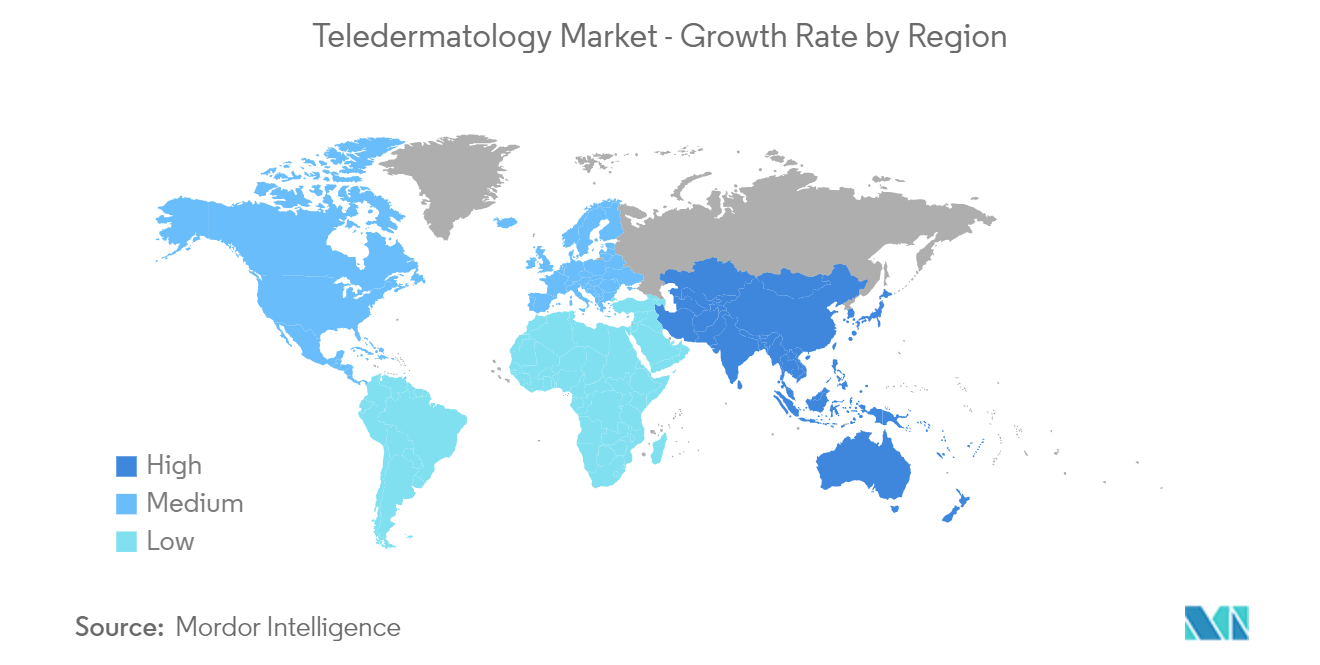
Competitive Landscape
The teledermatology market is fragmented due to the presence of several companies operating globally and regionally. The competitive landscape includes an analysis of a few international and local companies that hold significant market share and are well known, including Miiskin, Teladoc Health Inc., MDLIVE, DermatologistOnCall, First Derm, 3Derm, MetaOptima Technology Inc., Cureskin, Practo, MFine Pvt Ltd, American Well, and Doctor On Demand.
Teledermatology Industry Leaders
-
Teladoc Health, Inc.
-
American Well
-
MDLIVE
-
DermatologistOnCall
-
Doctor On Demand
- *Disclaimer: Major Players sorted in no particular order
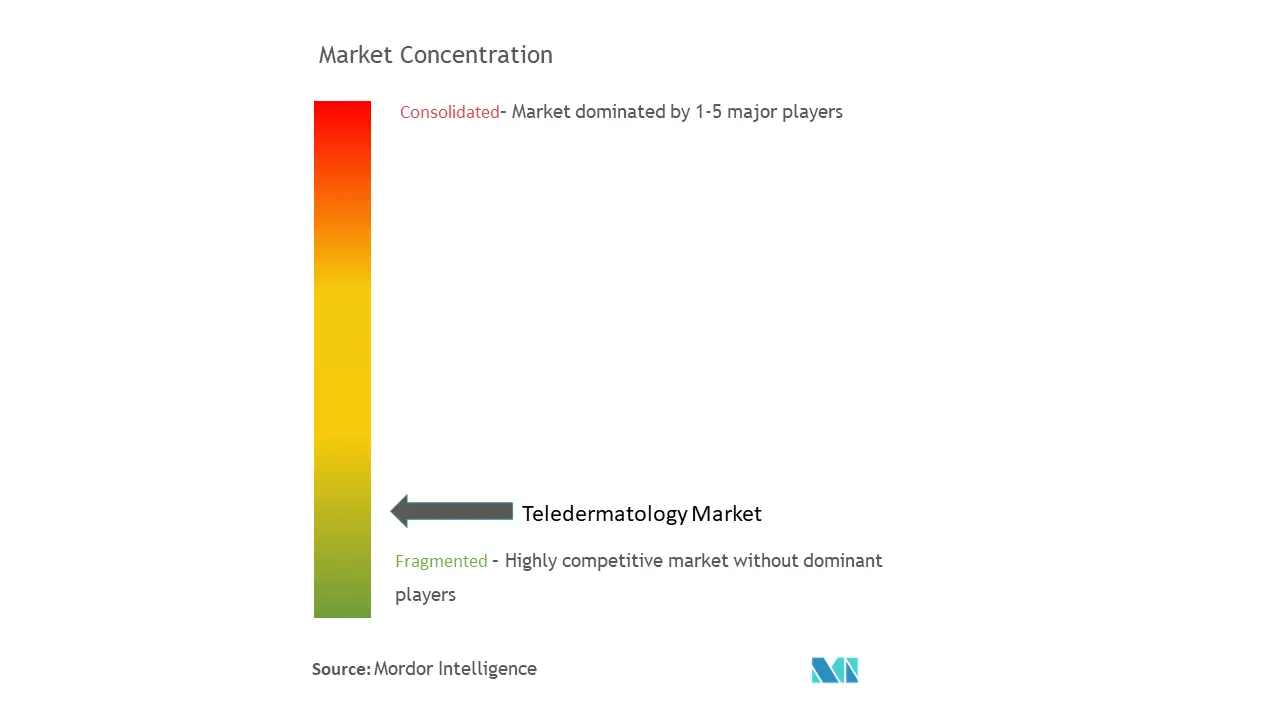
Recent Industry Developments
- February 2024: MEDX HEALTH CORP, a teledermatology company, completed a pilot project with Health Partners in the United Kingdom. MedX and Health Partners will partner to launch MedX’s DermSecure screening platform to serve a broad client base comprising corporates, government agencies, insurers, health trusts, pension funds, and individuals with telehealth, mobile, and on-site operations across the United Kingdom and the Republic of Ireland.
- June 2023: DeepX Diagnostics Inc., a skin cancer teledermatology and diagnostics company, received clearance from the United States Food and Drug Administration for its digital dermatoscope DermoSight. It is a medical device used for teledermatology screening suspected skin cancer lesions in the United States.
Global Teledermatology Market Report Scope
Teledermatology is a branch of telemedicine that uses telecommunication technology to provide dermatological care remotely. It involves using video conferencing, digital imaging, and other telecommunication tools to diagnose and treat skin conditions. The teledermatology market is segmented into component, modality, end user, and geography. By component, the market is segmented into products and services. By modality, the market is segmented into store and forward, real-time, and hybrid. By end user, the market is segmented into hospitals, dermatology clinics, and home care. By geography, the market is segmented into North America, Europe, Asia-Pacific, Middle East and Africa, and South America. The report also offers the market size and forecasts for 17 countries across the regions. For each segment, the market sizing and forecasts have been done on the basis of value (USD).
| Products |
| Services |
| Store and Forward |
| Real Time |
| Hybrid |
| Hospitals |
| Dermatology Clinics |
| Homecare |
| North America | United States |
| Canada | |
| Mexico | |
| Europe | Germany |
| United Kingdom | |
| France | |
| Italy | |
| Spain | |
| Rest of Europe | |
| Asia-Pacific | China |
| Japan | |
| India | |
| Australia | |
| South Korea | |
| Rest of Asia-Pacific | |
| Middle East and Africa | GCC |
| South Africa | |
| Rest of Middle East and Africa | |
| South America | Brazil |
| Argentina | |
| Rest of South America |
| By Component | Products | |
| Services | ||
| By Modality | Store and Forward | |
| Real Time | ||
| Hybrid | ||
| By End User | Hospitals | |
| Dermatology Clinics | ||
| Homecare | ||
| Geography | North America | United States |
| Canada | ||
| Mexico | ||
| Europe | Germany | |
| United Kingdom | ||
| France | ||
| Italy | ||
| Spain | ||
| Rest of Europe | ||
| Asia-Pacific | China | |
| Japan | ||
| India | ||
| Australia | ||
| South Korea | ||
| Rest of Asia-Pacific | ||
| Middle East and Africa | GCC | |
| South Africa | ||
| Rest of Middle East and Africa | ||
| South America | Brazil | |
| Argentina | ||
| Rest of South America | ||
Key Questions Answered in the Report
How big is the Teledermatology Market?
The Teledermatology Market size is expected to reach USD 16.30 billion in 2025 and grow at a CAGR of 18.40% to reach USD 37.94 billion by 2030.
What is the current Teledermatology Market size?
In 2025, the Teledermatology Market size is expected to reach USD 16.30 billion.
Who are the key players in Teledermatology Market?
Teladoc Health, Inc., American Well, MDLIVE, DermatologistOnCall and Doctor On Demand are the major companies operating in the Teledermatology Market.
Which is the fastest growing region in Teledermatology Market?
Asia Pacific is estimated to grow at the highest CAGR over the forecast period (2025-2030).
Which region has the biggest share in Teledermatology Market?
In 2025, the North America accounts for the largest market share in Teledermatology Market.
What years does this Teledermatology Market cover, and what was the market size in 2024?
In 2024, the Teledermatology Market size was estimated at USD 13.30 billion. The report covers the Teledermatology Market historical market size for years: 2019, 2020, 2021, 2022, 2023 and 2024. The report also forecasts the Teledermatology Market size for years: 2025, 2026, 2027, 2028, 2029 and 2030.
Page last updated on:
Teledermatology Market Report
Statistics for the 2025 Teledermatology market share, size and revenue growth rate, created by Mordor Intelligence™ Industry Reports. Teledermatology analysis includes a market forecast outlook for 2025 to 2030 and historical overview. Get a sample of this industry analysis as a free report PDF download.
